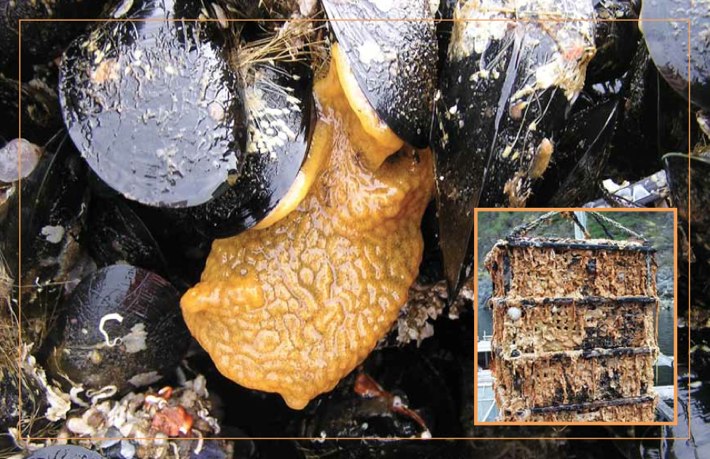Alien Invaders?
Subtidal alien invaders swarm, swelling into a slimy mass that grows and covers the shores of the Salish Sea!
Or maybe not.
While headlines about invasive tunicates have at times reached the breathless pitch of ads for campy horror films, there was legitimate concern because invasive tunicates in other regions of North America have severely impacted the aquaculture industry. Our Pacific Northwest shellfish industry annually pumps millions of dollars into the local economy. Introduced tunicates could potentially cause ecological and financial disaster.
Several years ago, Washington State began tracking and eradicating the invasives. Teams of scuba divers used ice scrapers and even blow- torches to remove tunicates at low tide, and divers removed a ton of them from just two marinas.
But is all of this effort needed? To find out, SeaDoc supported Jeff Cordell and colleagues at the University of Washington to collect and analyze data on the impact of these tunicate species. Refreshingly, we do not appear to be facing a worst-case scenario. The research found little evidence that the three tunicate species of most concern are damaging our local ecosystem and our valuable shellfish industry. That’s great news for our local shellfish, which, unfortunately, are already under serious, headline-worthy assault from acidifying waters.
The scientific paper
View the citation for Jeff Cordell's paper. If you'd like to read the full manuscript but don't have access, please contact us at seadoc@seadocsociety.org.
More findings from the study
Just because the invasive tunicates aren't causing major problems for aquaculture doesn't mean they are a good thing.
In their paper, Cordell and others state that "While invasive tunicates have not yet been demonstrated to have dire ecological or economic effects in Puget Sound, they are still a high priority for monitoring." Three species in particular (S. clava, D. vexillum, and C. savignyi) are relative newcomers to the region and their distributions and accompanying effects may not have reached full potential.
A few interesting associations they noted include:
A harpacticoid (D. vulgaris) found in the diets of juvenile salmon and other fishes tended to be less abundant in the presence of tunicates.
The amphipod A. columbiae was usually less abundant with tunicates.
More information on invasive tunicates
Janna Nichols has a good overview page about invasive tunicates on her Pacific Northwest Scuba blog. She includes pictures, a guide to identification. http://www.pnwscuba.com/invasives/
For a sense of the media coverage from the 2007 & 2008 period when invasive tunicates first came onto the public consciousness, see this piece from Ann Dornfeld of KUOW or this one from Warren Cornwall of the Seattle Times.
More recently, invasive tunicates made the news with the arrival on the Oregon coast of a floating dock from Japan that broke loose during the 2011 tsunami. KUOW's EarthFix covered it in two different pieces (here and here).
Videos
BBC videographer's piece on Didemnum vexillum in Wales
The Carpet Seasquirt - Didemnum vexillum (explanatory video from Wales, featuring the same scientist from the first video. Less polished.)
Didemnum sp. in Long Island Sound (underwater video from NOAA and U Conn)
Fun facts about tunicates (Smithsonian Tropical Research Institute)
More pictures
Not all tunicates are invasive, and many are strikingly beautiful. See some of the tunicate images people have posted to Flickr.
Invasive tunicates on mussel aquaculture. Photos by Gordon King, Taylor Shellfish



